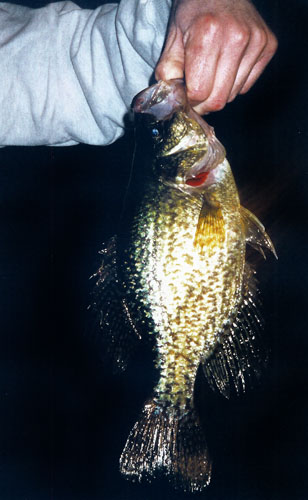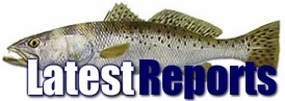 FISHING ARTICLES
FISHING ARTICLES  A SACALAIT A DAY
A SACALAIT A DAY
A SACALAIT A DAY
| Article Index |
|---|
| A SACALAIT A DAY |
| sacaliat |
| All Pages |
 At 2:30 p.m. Jan 1, 1998, most of the nation was either recovering from a previous night’s hangover or parked in front of a television watching bowl games. Randy Lewis was not one of them. The Houma native I call “Doctor Sac” was about to celebrate the New Year in a very special way - a first place listing in the Louisiana State record book.
At 2:30 p.m. Jan 1, 1998, most of the nation was either recovering from a previous night’s hangover or parked in front of a television watching bowl games. Randy Lewis was not one of them. The Houma native I call “Doctor Sac” was about to celebrate the New Year in a very special way - a first place listing in the Louisiana State record book.
That morning started chilly, as do most south Louisiana mornings following the passage of a cold front. It was a typical high-pressure day that would see the high temperature climb to 63 degrees and a light southeast wind. He worked his "vertical swimming jig" around a sunken willow top where he, from his meticulous records if not mental recall, remembered catching a 1 ¾-pound black crappie on a previous trip.
"The fish struck about 12-inches below the surface and ran to the middle of the canal. After it made 3 sweeping runs I got a glimpse of the fish as it shook its head trying to free the barbless hook," Lewis said for probably the umpteenth time since that day.
 The white crappie officially weighed in at 2-pounds, 13-ounces and is the largest ever caught in the state since the two species were grouped into separate categories in 1994. The old category, which was open for both species native to Louisiana, the black crappie (Pomoxis nigromaculatus) and the white crappie (Pomoxis annularis) has been closed. The 6-pound monster caught by Lettie Robertson in November of 1969 leads that list of top ten, all-time sacalait. But even though his 2-13 white crappie has an asterisk by its listing, Randy Lewis is no less proud of his current first place fish.
The white crappie officially weighed in at 2-pounds, 13-ounces and is the largest ever caught in the state since the two species were grouped into separate categories in 1994. The old category, which was open for both species native to Louisiana, the black crappie (Pomoxis nigromaculatus) and the white crappie (Pomoxis annularis) has been closed. The 6-pound monster caught by Lettie Robertson in November of 1969 leads that list of top ten, all-time sacalait. But even though his 2-13 white crappie has an asterisk by its listing, Randy Lewis is no less proud of his current first place fish.
"The fish I caught that day was the end result of 19 years of hard fishing. And the strange thing about it was it the same day that a record speckled trout was caught at the Sulfur Mine. I guess it was just one of those big fish days," Lewis said.
The trout he mentioned was a 10-pound, .09 ounce speck caught by David Medine that very same New Year’s Day in Lafourche Parish. It currently ranks fifth in the category.
Many times, some folks believe most times, record fish are the result of luck. But anyone who has ever fished or even talked sacalait fishing with Lewis will tell you his catch was much more than luck. First off he understands fish. By that I mean he knows fish biology and fishery management. And that gives him a distinct advantage in knowing the habits and tendencies of several species of fish. And that gives him an edge when it comes to catching his favorite species, sacalait.
Secondly, he's out there frequently, which puts the odds heavily in your favor to catch more fish. And I don't mean he fishes what most people would consider a lot, say once every week. That would probably be enough to earn at least a few complaints from a non-understanding spouse. Randy averages a whopping 100 sacalait trips per year - and that doesn’t include outings for other freshwater species or any of his saltwater trips! In 1998 Randy made an even 100 sacalait trips that yielded a total of 2,631 fish. Not particularly a good year by his own admission. "I'll average about 3,000 sacs a year. My best year was 1991 when I caught 7,000. That year on one trip I caught and released 217 in nine hours," the carpenter who loves fishing said.
As mentioned before Lewis has a keen understanding of fish resources and can intelligently discuss the issues as articulately as any trained fish biologist I’ve ever interviewed. But what is probably Randy's biggest asset in consistently finding and catching fish are his records. Lewis has maintained detailed records of his catches since 1987. And over the last 12 years he has logged weather and water conditions, fishing times and extensive data from every trip. He identifies each fish according to species, measures it noting special markings, injuries or other oddities and adds it to the count. The data he has amassed from his usual haunts rivals that of any public agency. Consequently, he has a wealth of information to draw from when planning a trip to any of his hotspots under a wide range of climactic conditions. That's why I call him "Dr. Sac."
By now, if you’re like any red-blooded Louisiana sacalait lover, you’re asking the same questions I wanted answered. Where, when and how does he do it? Oh yeah, and what does he do with all those fish?
I'll start with the last question first. Doctor Sac releases many more fish then he keeps. But he as well as anyone knows that the sweet sacalait lives up to its Cajun namesake translating to "sack of milk." Keeping only what he needs, Randy carefully handles and releases all smaller and plenty of the bigger fish.
"I think we really need to take a hard look at more restrictive management in Louisiana. I’ve witnessed a decline in the fish and I think we need to lower the creel limit. Fifty fish per person is just too many and we probably should establish a minimum size too," he said.
Now for the where, when and how. Most sacalait fishermen only fish for them when they are the easiest to catch. Lewis fishes sacalait every month of the year and adjusts his tactics seasonally. His favorite times are November-December and May-June and he alternates fishing areas between the Lake Verret system and the Des Allemands area.
"I find the fish are most active in late fall and early winter. And that's usually when I'll catch the most big fish," the doctor prescribed. You would think that someone as successful a sacalait angler as Lewis would use a wide array of baits and methods. But the Doc's success is based on simplicity. Randy has been fishing sacalait basically the same way he has for the last 20 years.

